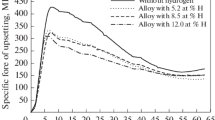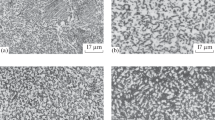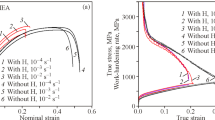Abstract
The effects of combined oxygen and hydrogen on the temperature dependence of the yield stress and ductility of V, Nb, and Ta have been investigated over the temperature range 295 to 78 K. In V the combined effects of oxygen and hydrogen on the yield stress were greater than those expected from a sum of the individual contributions, whereas, in Nb and Ta the sum of the individual contributions was similar to the combined contribution. The combined effect of oxygen and hydrogen on ductility of V, Nb, and Ta was similar to that of hydrogen alone and resulted in a ductile-brittle transition behavior. Oxygen by itself had no significant influence on the ductility of these metals. In general, the presence of oxygen in hydrogenated V, Nb, and Ta decreased the hydride solvus temperature(T s), but it did not affect the ductile-brittle transition temperature (DBTT). There was no apparent correlation between DBTT andT s in these alloys. Models based on equilibrium hydride precipitates for strengthening or stress induced hydrides at a propagating crack for embrittlement appear inadequate for explaining the observed mechanical behavior in these Group VA metals.
Similar content being viewed by others
References
H. Y. Chang and C. A. Wert:Acta Metall., 1973, vol. 21, pp. 1233–42.
D. G. Westlake and S. T. Ockers:Metall. Trans. A, 1975, vol. 6A, pp. 399–402.
G. Pfeiffer and H. Wipf:J. Phys. F: Metal Phys., 1976, vol. 6, pp. 167–79.
K. Rosan and H. Wipf:Phys. Status Solidi (a), 1976, vol. 38, pp. 611–20.
W. A. Spitzig, C. V. Owen, and T. E. Scott:Metall. Trans. A, 1986, vol. 17A, p. 527.
D. H. Sherman, C. V. Owen, and T. E. Scott:Trans. TMS-AIME, 1968, vol. 242, pp. 1775–84.
D.G. Westlake:Trans. TMS-AIME, 1969, vol. 245, pp. 1969–73.
C.V. Owen and T.E. Scott:Metall. Trans., 1972, vol. 3, pp. 1715–26.
J. Puhr-Westerheide and G. Elssner:J. Less-Common Metals, 1970, vol. 20, pp. 371–74.
G. Elssner and G. Hörz:J. Less-Common Metals, 1970, vol. 21, pp. 451–55.
G. Elssner and G. Hörz:J. Less-Common Metals, 1971, vol. 23, pp. 237–40.
G. Hörz:Metall, 1976, vol. 8, pp. 728–31.
G. Hörz:Metall, 1976, vol. 8, pp. 731–36.
G. Hörz:Metall, 1977, vol. 10, pp. 1–6.
W. A. Spitzig, C.V. Owen, T. J. Rowland, and O. Buck:J. Less- Common Metals, 1985, vol. 115, pp. 45–56.
C.C. Chen and R.J. Arsenault:Acta Metall., 1975, vol. 23, pp. 255–67.
O.N. Carlson, D.G. Alexander, and G. Elssner:Metall. Trans. A, 1977, vol. 8A, pp. 99–104.
K. V. Ravi and R. Gibala:Acta Metall., 1970, vol. 18, pp. 623–34.
J. C. M. Li: inDislocation Dynamics, A. R. Rosenfield, G. T. Hahn, A.J. Bernent, Jr., and R.I. Jaffee, eds., McGraw-Hill, New York, NY, 1968, pp. 87–116.
R. L. Fleischer: inThe Strengthening of Metals, D. Peckner, ed., Reinhold Publishing Co., London, 1964, pp. 93–140.
R. Labusch:Phys. Status Solidi, 1970, vol. 41, pp. 659–69.
R.L. Smialek and T. E. Mitchell:Phil. Mag., 1970, vol. 22, pp. 1105–27.
E. Fromm and E. Gebhardt: inGase and Kohlenstoff in Metallen, Springer-Verlag, New York, NY, 1976, pp. 441–520.
B.L. Mordike and K. D. Rogausch: inProc. 2nd Intern. Conf. Strength of Metals and Alloys, Am. Soc. Metals, 1970, vol. 1, pp. 258–61.
W. A. Spitzig:Mater. Sci. Eng., 1974, vol. 16, pp. 169–79.
J. O. Ratka, V. K. Sethi, and R. Gibala: inMechanical Properties of BCC Metals, Proceedings of the U .S.-Japan Seminar, Metall. Soc. of AIME, M. Meshii, ed., 1981, pp. 103-09.
D.G. Westlake:Trans. TMS-AIME, 1969, vol. 245, pp. 287–92.
H.K. Birnbaum: inMechanical Properties of BCC Metals,Proceedings of the U.S.-Japan Seminar, Metall. Soc. of AIME, M. Meshii, ed., 1981, pp. 153-69.
C. V. Owen and W. A. Spitzig: unpublished research, Ames Labora- tory, Iowa State University, Ames, IA, 1985.
R. Hempelmann:J. Less-Common Metals, 1984, vol. 101, pp. 69–96.
Author information
Authors and Affiliations
Additional information
T. E. SCOTT, formerly with Ames Laboratory, is with Michigan Technological University, Houghton, MI 49931.
Rights and permissions
About this article
Cite this article
Spitzig, W.A., Owen, C.V. & Scott, T.E. Effects of oxygen on the mechanical behavior of hydrogenated V, Nb, and Ta. Metall Trans A 17, 853–859 (1986). https://doi.org/10.1007/BF02643861
Received:
Issue Date:
DOI: https://doi.org/10.1007/BF02643861




